|
7 Town Pier
Royal Pier Road
Gravesend
01474 566869
https://www.threedaws.co.uk/
https://whatpub.com/three-daws
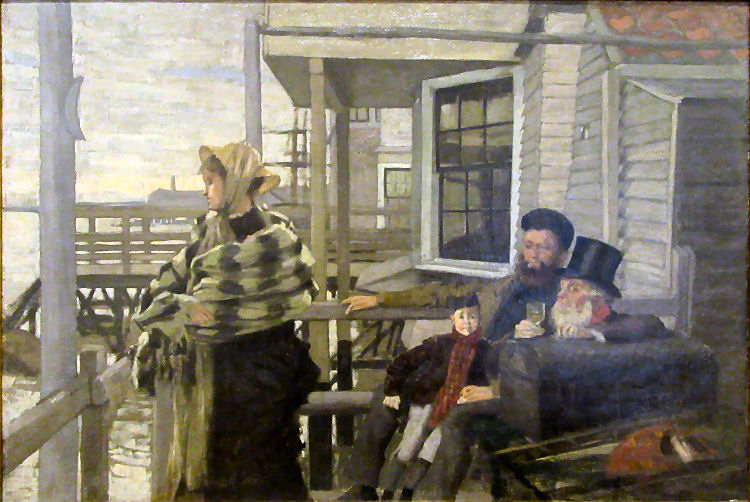
Above painting titled L'Auberge des Trois-Corbeaux (The Three Crows Inn,
Gravesend) by James Tissot 1873. Crows and Daws meaning the same bird.
At the time the area was a departing place for ships to Australia and
new Zealand. |
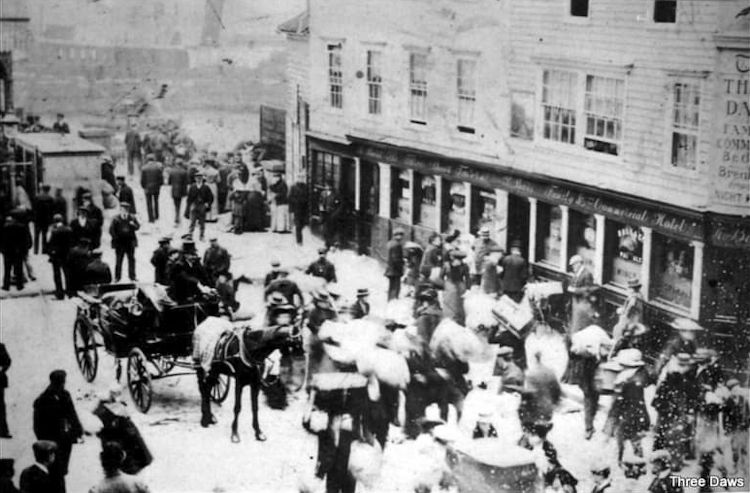
Above photo, date unknown. |

Above photo, date unknown. Kindly supplied by John Hopperton. |

Above photo kindly sent by Jason Kemsley and Tom Baines. The "Castle"
is the building on the right. |
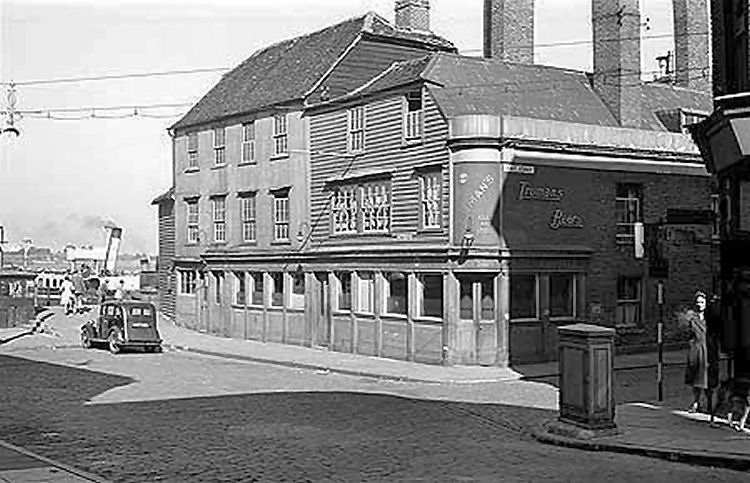
Above photo, date unknown. Kindly supplied by John Hopperton. |

Above photo showing the "Three Daws," "Falcon Hotel,"
"King of Prussia,"
and "Old Amsterdam." 4 in a row. |
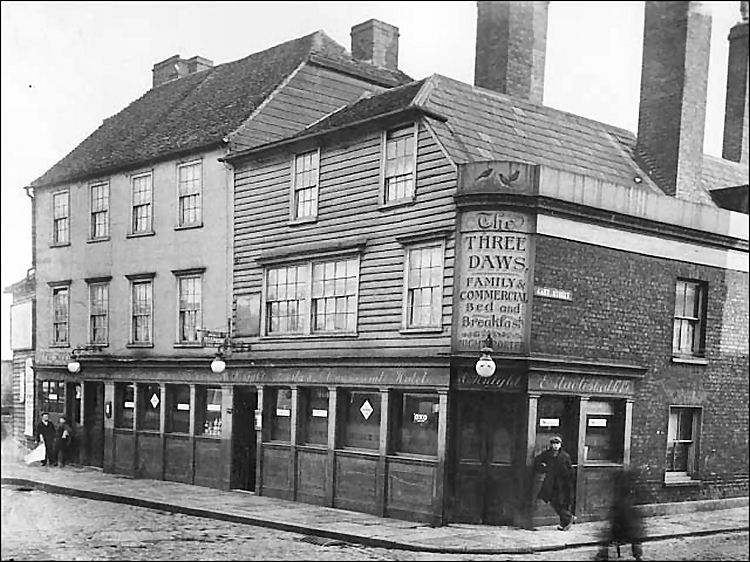
Above photo 1915. |

Above photo, date unknown, showing the rear of the "Three Daws." |
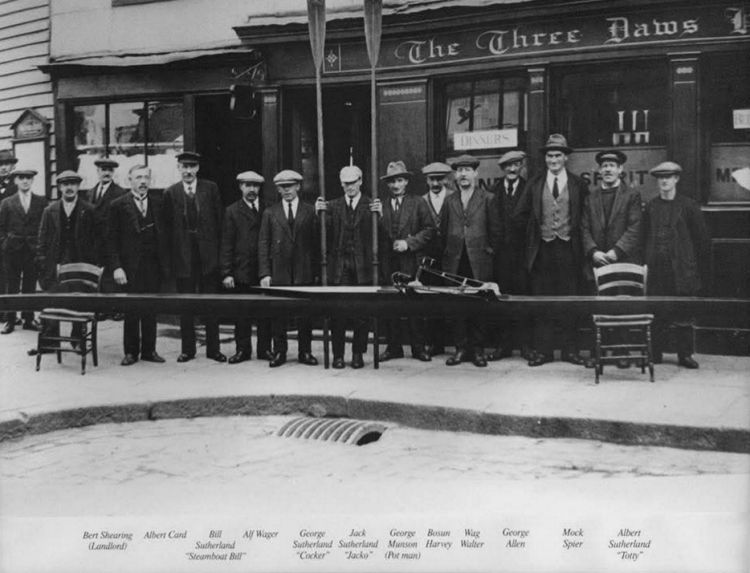
Above photo, date unknown, showing from L to R, Bert Shearing
(landlord), Albert Card, Bill Sutherland "Steamboat Bill", Alf Wager,
George Sutherland "Cocker", Jack Sutherland, "Jacko", George Munson (Pot
man), Bosun Harvey, Wag Walter, George Allen, Mock Spicer, Albert
Sutherland "Totty." |
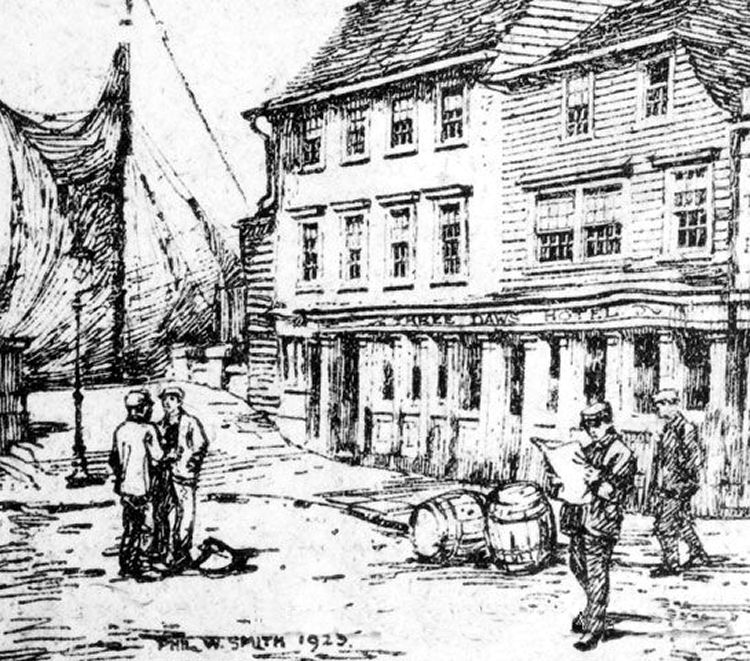
Above drawing 1925. |
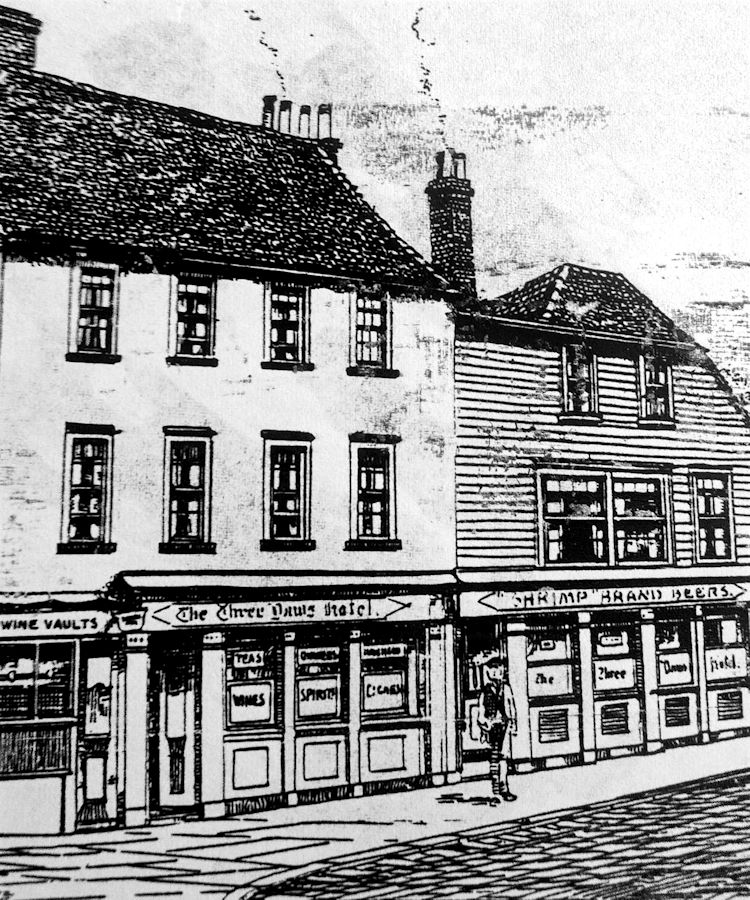
Above sketch, date unknown. |

Above photo, March 1950, kindly sent by Rory Kehoe, Mr. H. Perry behind the bar. |
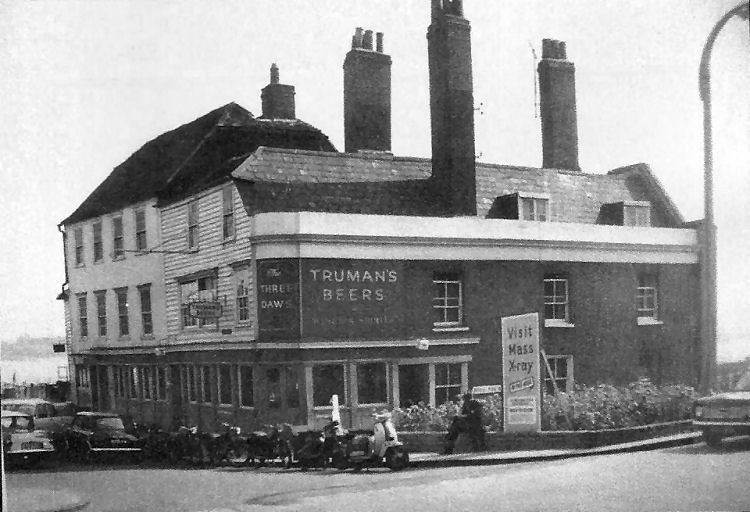
Above photo 1967. |

Above licensees possibly Lester Banks, circa 1988, as it appeared in
a round-up of what Kent was doing in that year recently. Both the pump
clips (Webster's & Ruddle's) were Real Ale brands in the Watney's stable
at that time. |
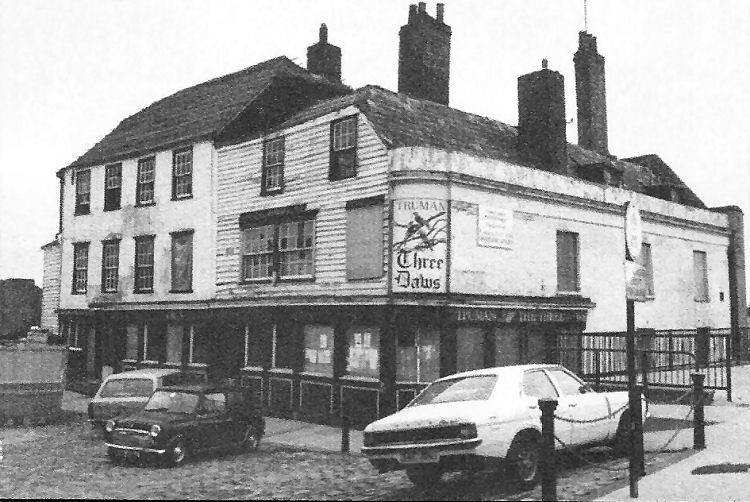
Above photo, 1985. |
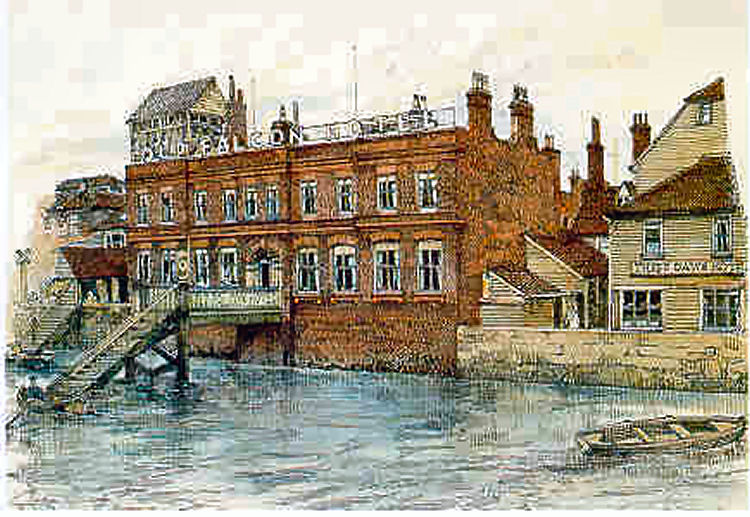
Above painting, date unknown, kindly sent by Susan Clark. |

Above photo, date unknown. |
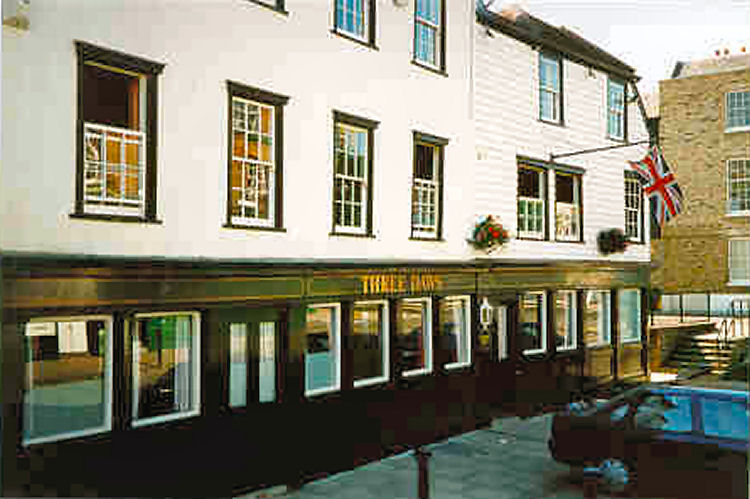
Above photo 2000, kindly sent by Susan Clark. |
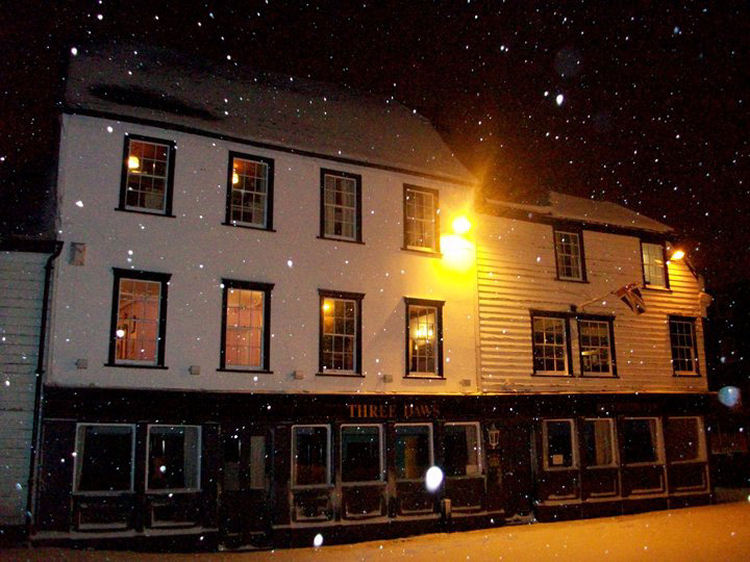
Above photo 2013. |
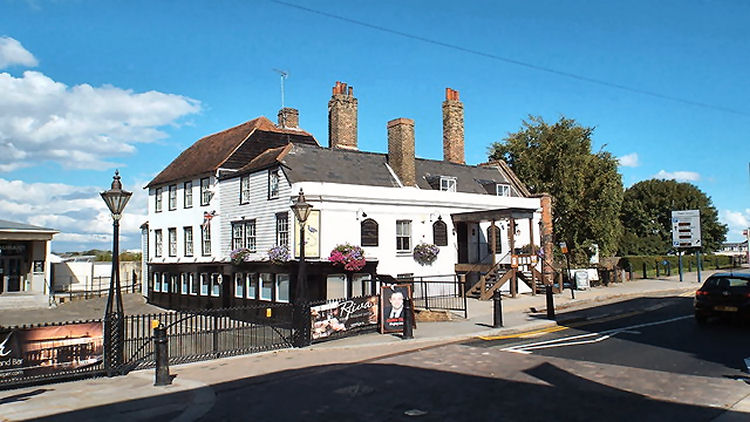
Above photo 2013 by Malc McDonald
Creative Commons Licence. |
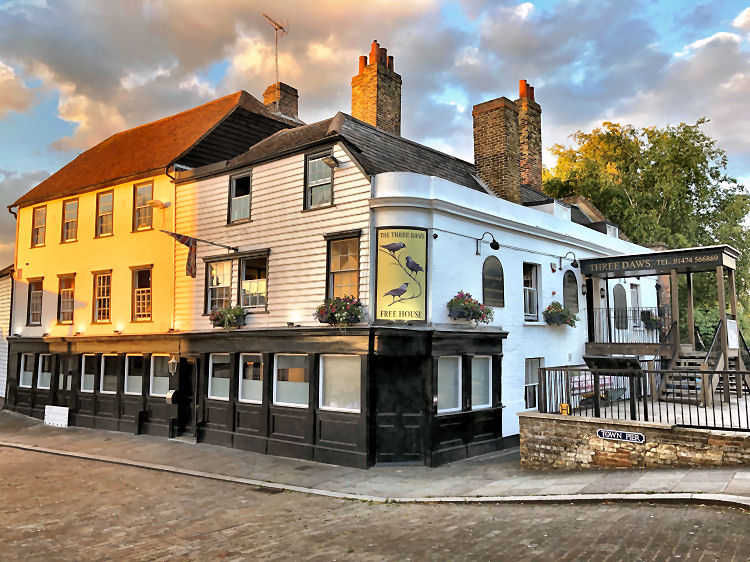
Above photo, 2019, kindly sent by Shaun Gardiner. |
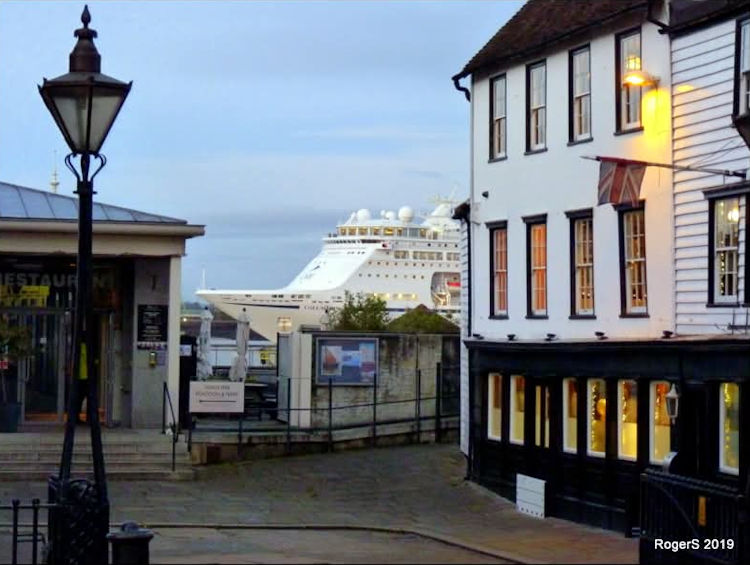
Above photo, 2019 by Roger S. |
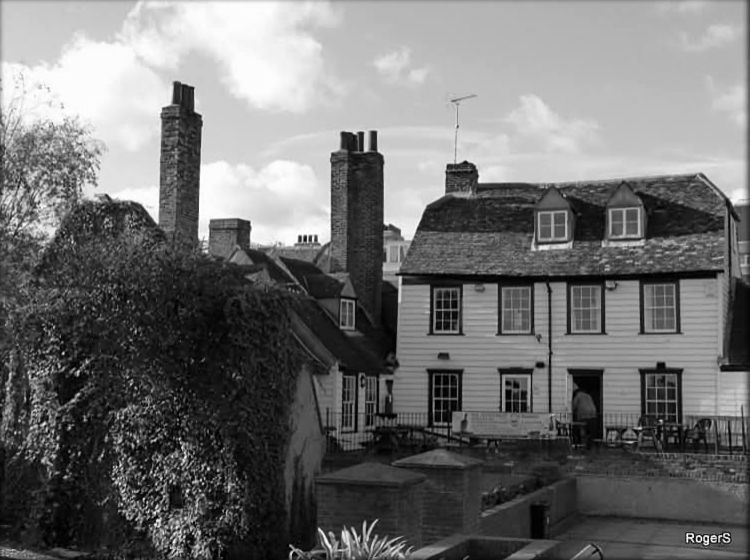
Above photo 2025, by Roger S. |
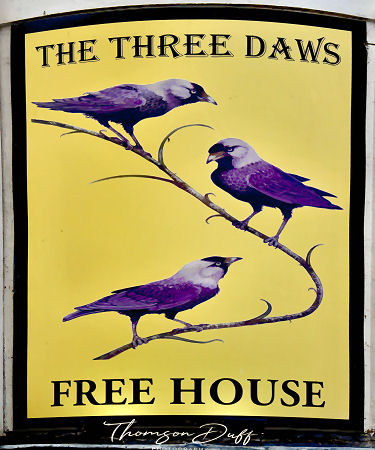
Above sign, 2019, kindly taken and sent by Tom Duff. |
The building dates from 1488 and was serving ales by 1551. This is said
to be oldest public house in Gravesend, with many passages and stairs to aid
smugglers and those hoping to escape the press gang. Its earlier name was
the "Cornish Chough," and later
the "Three Cornish Choughs." It
may have been associated with pilgrims crossing the river en route to
Canterbury; the three Cornish Choughs are on the Canterbury arms. It was
originally five wood fronted cottages probably dating as early as 1488. Its
wooden structure thought to be the work of shipwrights. Once used as a hotel
it had eleven bedrooms, connected by five staircases. It remains open today
(2018).
It is said that the premises boasted no less then seven staircases to
ensure that the smugglers in the pub could always make a getaway.
The Three Daws, a Grade II listed building on the east side of the Town
Pier square, is now the oldest public house in the town and probably the
oldest pub in Kent with its mixture of timber framing, weatherboarding and
tiled roof. The "Three Daws" and the Old Pilots' House to the rear (now
demolished) are reported to have had seven staircases and three underground
tunnels enabling sailors to escape the press gang and smugglers to ply their
trade.
By some miracle, the "Three Daws" escaped the many fires, in spite of its
wooden construction. Its earlier name was the "Cornish Chough" (1488 1707),
and later the "Three Cornish Choughs" (1707 1778). In 1582, the innkeeper
was Ralph Wellett. It seems to have been associated with pilgrims crossing
the river on their way to the shrine of St. Thomas, the three Cornish
Choughs appearing in the arms of Canterbury City. A reference to it as the
"Three Daws" appears in the Gravesend Register of 1667.
|
From their web site at
http://www.threedaws.co.uk
HISTORY OF THE BUILDING
Standing at the river edge at the foot of the old High Street, it has
for centuries served as a home from home for the river men, been the
haunt of smugglers and was regularly raided by the old naval press
gangs.
It is older than Shakespeare's house, older than many well known
ancient buildings, and is a place to reflect on past and very hard
times.
One of the oldest taverns in the country - this ancient inn (now
named) the Three Daws is almost four hundred and fifty years old and
first gained its licence in 1565.
The Three Daws began its life by being converted from five
traditional styled wood fronted cottages. The general structure is
therefore some years older that the length of its history as a Thames
tavern, and probably goes further back to at least 1501.
A rambling building typical of its period, the wooden structure of
its construction is reputed to be the work of shipwrights who were
seeking work at that time, owing to a depression in their waterside
trade.
During the days of the big sailing merchant ships of two centuries
ago, it was also used as an accommodation and it had eleven bedrooms,
connected by five complete staircases.
The outer structure has evidence of fire damage in its history,
particularly where the wood front has been replaced by plaster facing
and brickwork. However, during the great fire of 1727, the main
structure was undamaged by the disaster which did manage to reach the
surrounding properties.
A small extension at the North of the main building has its own
independent record, for it was once separated from the tavern and used
as steam packet offices... Later it became a reading room for the local
watermen until brought in to use as steam tug offices.
At one time large sailing merchant ships used to anchor off the Three
Daws while awaiting supplies and a fair wind or, on returning from long
overseas voyages. Back in those days, the waterside tavern was a very
popular place for seamen of all nationalities, echoing to the sound of
the sea shanties whilst liquid refreshments were consumed by the gallon.
A century or more ago, the Three Daws was just one of a large number
of taverns catering for waterside people along the front. Other nearby
houses included the Falcon, King of Prussia, and the very famous
Amsterdam, which was immortalised in a well-known sea shanty.
In 1984, the Three Daws was closed for the first time in almost five
centuries. During all of the fires in Gravesend, including the great
fire of 1850, the Three Daws remained virtually unscathed. Today it is
owned by Mr. Lester Banks and was been sympathetically restored from 1985
and reopened in October 1988 to its
original charm and character.
So stay and enjoy the fayre and reflect on those bygone times. |
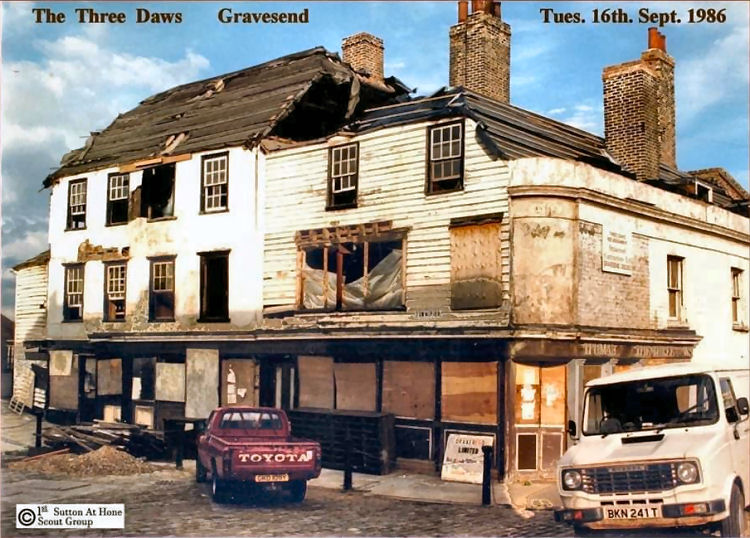
Above photo, 16 September 1986. |
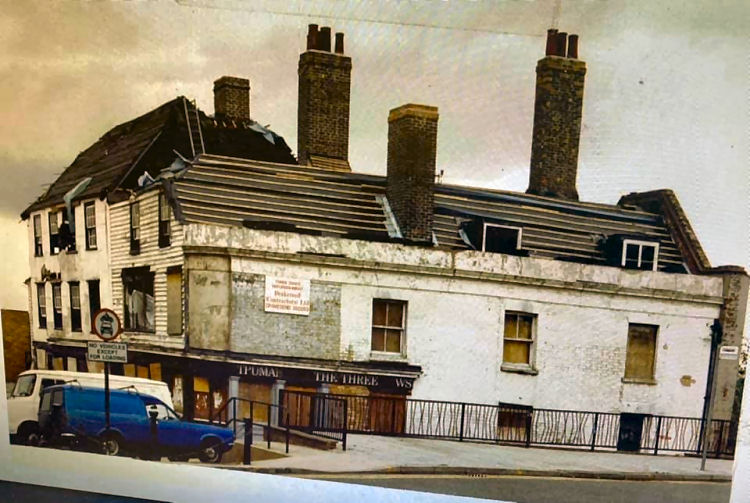
Above photo 1986. |
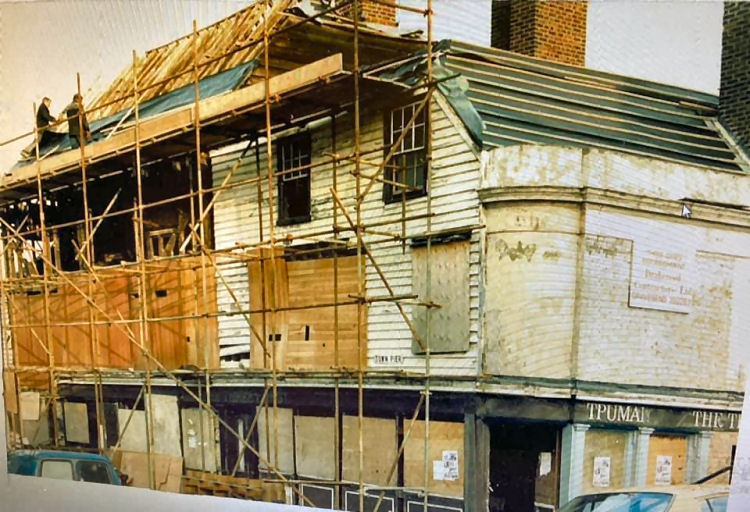
Above photo showing the renovation in 1986. |
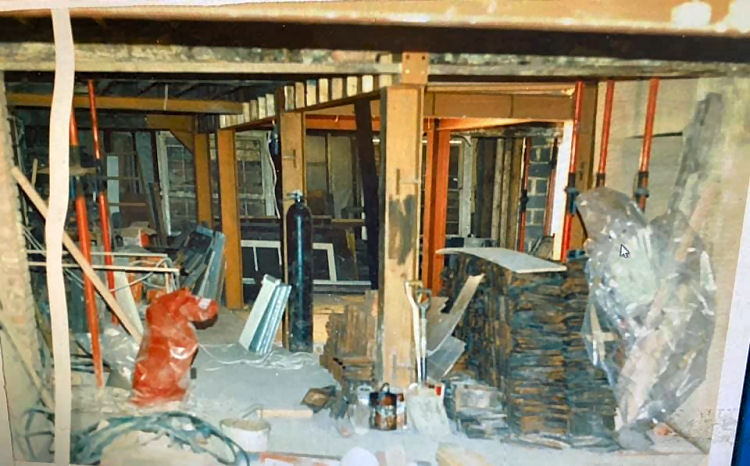
Above photo showing the inside 1986. |

Above photo showing the inside 1986. |
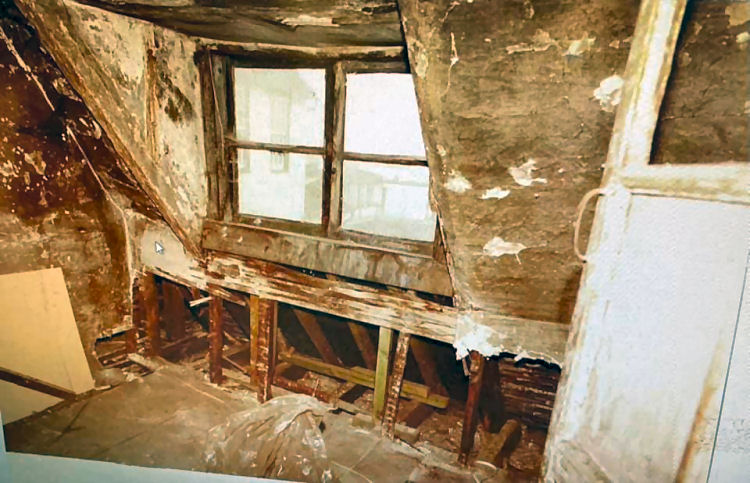
Above photo showing the inside 1986. |
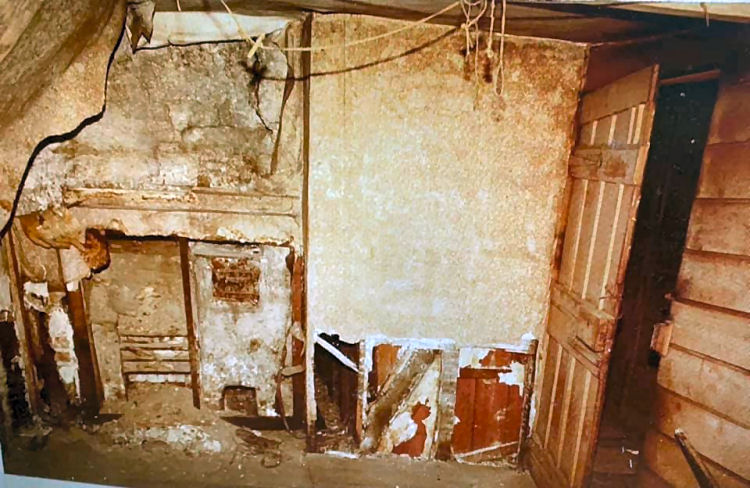
Above photo showing the inside 1986. |
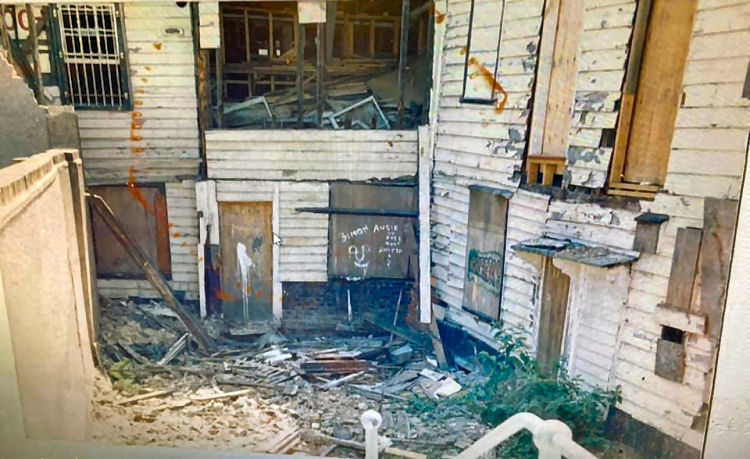
Above photo 1986. |
|
|
|
From the Kentish Gazette, 28 March 1837.
DEATHS.
Mr. Solomon Ribbens, of the "Three Daws," Gravesend. |
|
From the Kentish Gazette, 31 January 1843.
GRAVESEND.
An extraordinary suicide was committed by a man of the name of Wheeler,
a highly-respectable lighterman and waterman, residing at Gravesend. It
appears that the last time the deceased was seen alive was on Sunday
night, when he was at the "Three Daws" at Gravesend, and spent the
evening with his friends; he left there about nine o'clock, and nothing
unusual was observed in his manner. Soon afterwards his jacket and hat
were seen on the barge, near the pier, and this induced the man on duty
to order a search to be made in the river, and the means were speedily
supplied for the purpose. It was not long before the body was found,
very near the spot, and a most extraordinary evidence of the
determination of the suicide was witnessed. After leaving the "Three
Daws," he must have proceeded to one of the barges attached to the pier
at Gravesend and obtained a pig or iron, weighing between 50 and 100
pounds; each end of these "pigs," as they are technically called, has
holes for the purpose of removal when they are used as ballast. Having
obtained this, be placed a cord through the top part of it, and
suspended the immense weight round his neck, the ends were then closely
fastened round his waist, so that the "pig"’ could not remove from its
place. With this iron attached to his neck was the body taken out. The
deceased man was between 50 and 60 years of age; a man who had served in
most of our great naval wars, and was generally respected in Gravesend
for his uniform good conduct. Not the slightest motive has been
ascertained which could have led to the commission of such a desperate
act.
|
|
From Lloyd s Weekly Newspaper (London, England), Sunday, March 31, 1844; Issue 71.
ODDS AND ENDS. TWO LIVES LOST.
On Sunday morning the ferry-boat belonging to Mr.
Creed, of the World's End Ferry, Tilbury Fort, left the jetty in charge
of two men, named Bailey and Howard, having two passengers. The sail was
made fast, and a sudden squall upset the boat about three-quarters of a
mile from shore. Bailey and Howard sank, but the passengers were taken
up in an exhausted state, and conveyed to the "Three Daws" public-house,
Gravesend. |
LICENSEE LIST
SCRUGGS Thomas 1651+
SCRUGGS Lucy 1698+
SCRUGGS Richard 1705+
QUICK Cedric 1718+
SALMON Joseph 1722+
BENNING Jack 1736+
FRENCH Thomas 1742+
COOPER William 1754+
GRABBER Thomas 1769+
RIBBENS Esau 1783+
RIBBENS Solomon 1805-Mar/37 dec'd
 
RIBBENS Martha 1837-40+
BAKER Edward 1855+
BALL Frederick 1858-82+ (age 42 in 1861 ) )
BALL Catherine Mrs 1885-91+ (widow age 55 in 1891 ) )
BASS Kate Mrs 1903+

SHEARING Bert ????
KNIGHT Alfred 1913+
KNIGHT Alfred Knight exors of 1922+
PILCHER Alonin Bilham 1923+
KNIGHT S E Mrs 1928-38+
PERRY Harry H 1944-50+
KITE A E 1960+
CHIDGEY Charles 1966+
GAMMON Doris 1976+
BANKS Lester Mr 1985-2014+
https://pubwiki.co.uk/ThreeDaws.shtml
 From the Pigot's Directory 1828-29 From the Pigot's Directory 1828-29
 From the Pigot's Directory 1832-33-34 From the Pigot's Directory 1832-33-34
 From the Kelly's Directory 1903 From the Kelly's Directory 1903
 Census Census
|































